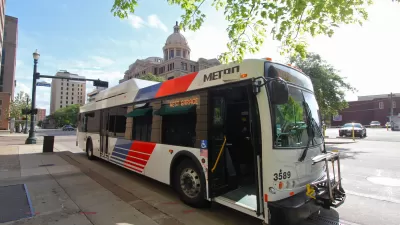Houston is making big transportation news this week with the launch of a newly replanned Metropolitan Transit Authority (Metro) bus system.
Here's a look around a variety of media outlets for a sample of the coverage on the first days of Metro's new bus system in Houston, which makes use of a high frequency grid and did not require a new source of transit funding.
Jarrett Walker provides insight, as the consultant that led the design process of the new system, into what the new system means for residents of Houston. Walker also shares a lot more links to local coverage of the system overhaul. His message: "Welcome, Houston, to a totally new transit system. And for everyone else, remember: If your bus network is obsolete, you can reimagine it to be more liberating and useful, and also to be more relevant to building the city you want."
Gail Delaughter previewed the launch of the new system a few days before it went live on August 16, 2015—focusing on Metro's customer service and outreach efforts. The roll out of the new system includes free rides from August 16-22.
Next, Madlin Mekelburg provided a boots-on-the-ground access to Metro employees as they guided users through the first business day of the system. The article followed Metro employee Barrett Ochoa, who is studying urban planning at Texas A&M University, as he offered bilingual guidance to Metro bus system users at the Texas Medical Center Transit Center.
Finally, Angie Schmitt picked up on the news and shared links to past coverage of the overhaul and notes that Columbus is working on a system redesign based on similar concepts.
FULL STORY: Houston: Welcome to Your New Network

Montreal Mall to Become 6,000 Housing Units
Place Versailles will be transformed into a mixed-use complex over the next 25 years.

Planetizen Federal Action Tracker
A weekly monitor of how Trump’s orders and actions are impacting planners and planning in America.

DARTSpace Platform Streamlines Dallas TOD Application Process
The Dallas transit agency hopes a shorter permitting timeline will boost transit-oriented development around rail stations.

Study: 4% of Truckers Lack a Valid Commercial License
Over 56% of inspected trucks had other violations.

Chicago Judge Orders Thousands of Accessible Ped Signals
Only 3% of the city's crossing signals are currently accessible to blind pedestrians.

Philadelphia Swaps Car Lanes for Bikeways in Unanimous Vote
The project will transform one of the handful of streets responsible for 80% of the city’s major crashes.
Urban Design for Planners 1: Software Tools
This six-course series explores essential urban design concepts using open source software and equips planners with the tools they need to participate fully in the urban design process.
Planning for Universal Design
Learn the tools for implementing Universal Design in planning regulations.
City of Mt Shasta
City of Camden Redevelopment Agency
City of Astoria
Transportation Research & Education Center (TREC) at Portland State University
US High Speed Rail Association
City of Camden Redevelopment Agency
Municipality of Princeton (NJ)



























